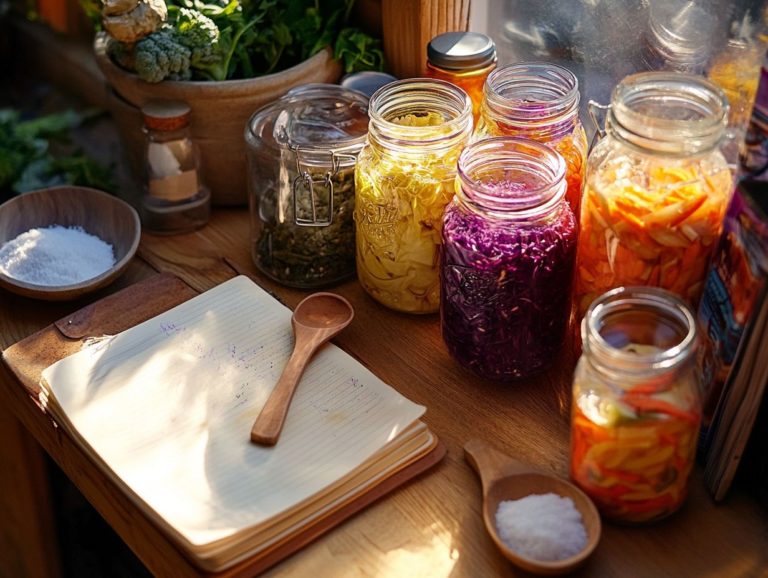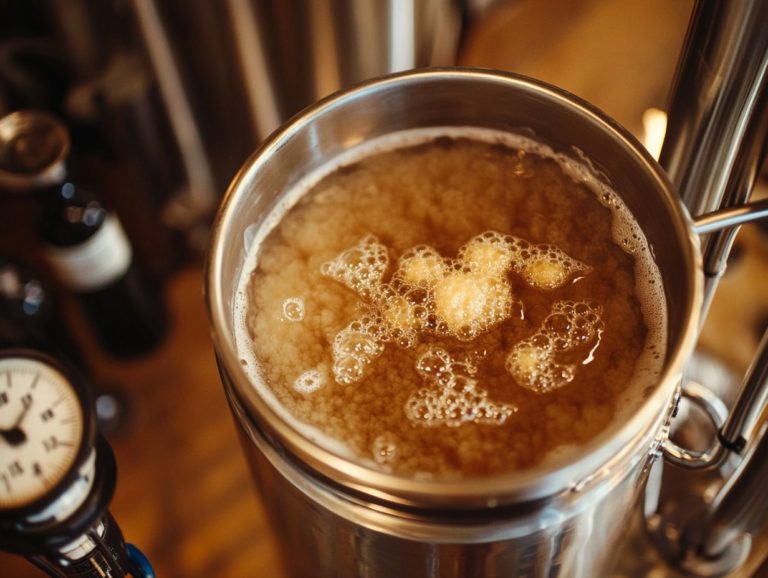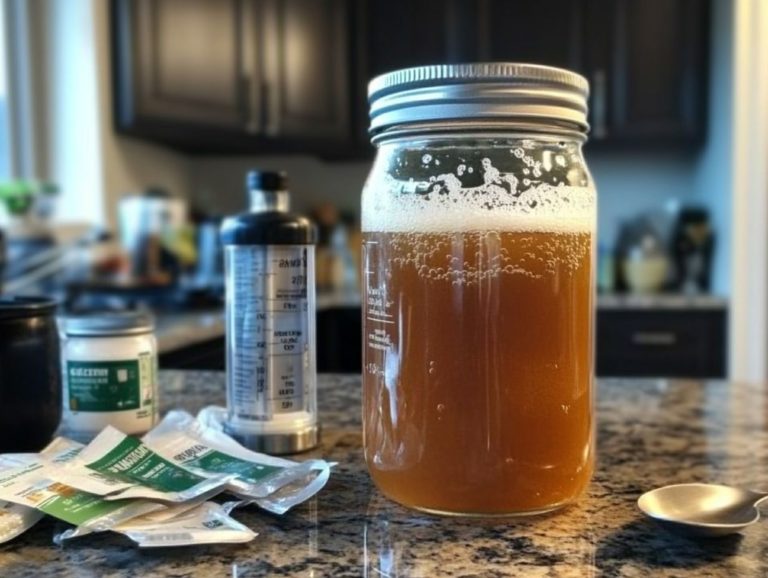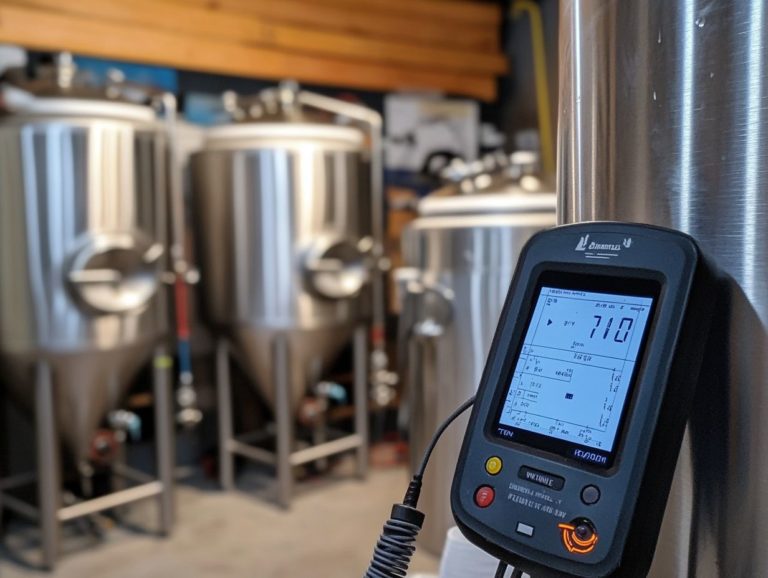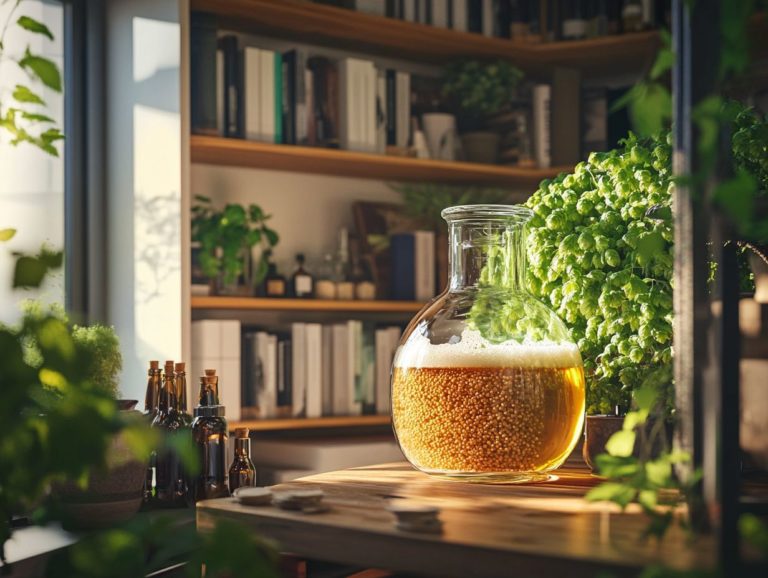The Role of Fermentation in Beer Mouthfeel
Contents
- The Role of Fermentation in Beer Mouthfeel
- Key Takeaways:
- What Is Fermentation?
- How Does Fermentation Affect Beer Mouthfeel?
- How Does Temperature Affect Fermentation and Mouthfeel?
- What Are the Key Factors in Achieving Desired Mouthfeel through Fermentation?
- How Can Fermentation Flaws Affect Beer Mouthfeel?
- Brewing Techniques for Enhanced Beer Quality
- Frequently Asked Questions
- What is fermentation and how does it affect the mouthfeel of beer?
- How does carbonation from fermentation impact the mouthfeel of beer? How does brewing water influence the final product?
- What role do esters play in the mouthfeel of beer during fermentation? How does the selection of yeast strains affect this?
- How does the alcohol content of beer impact its mouthfeel? What is the role of fermentation temperature?
- What role do acids play in the mouthfeel of beer during fermentation? How do calcium salts influence this?
- How Does the Length of Fermentation Impact the Mouthfeel of Beer?
The Role of Fermentation in Beer Mouthfeel
Fermentation is an intriguing process that takes simple ingredients and transforms them into beer, significantly influencing mouthfeel. This process is central to brewing science.
This article delves into the relationship between fermentation and the texture of beer. It examines how various factors from the selection of yeast strains to fermentation temperatures and the role of brewing water affect the final product.
You ll discover the different types of fermentation utilized in brewing, the potential flaws that may arise, and techniques available to enhance mouthfeel. From hop bio-transformation to the use of wheat adjuncts, the options are vast.
Whether you re a home brewer or a passionate beer enthusiast, understanding these concepts from yeast mixing to fermentation temperature will enrich your appreciation for this cherished beverage.
Key Takeaways:
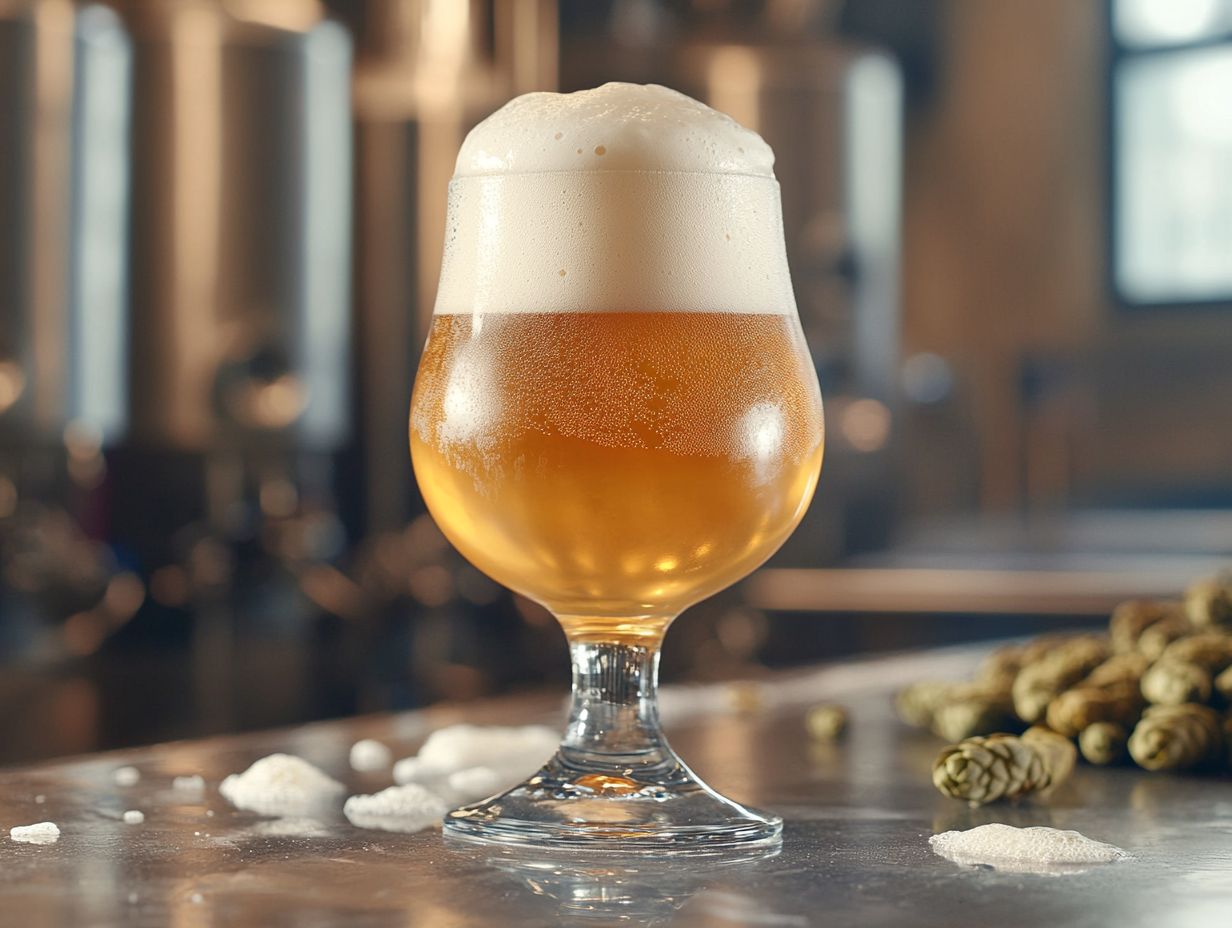
- Fermentation plays a crucial role in determining the mouthfeel of beer, influencing mouthfeel and aroma.
- Temperature and yeast strain selection are key factors in achieving desired mouthfeel through fermentation, impacting glycerol production and the mineral profiles of the beer.
- Improper fermentation can result in off-flavors that negatively impact the beer’s mouthfeel and alter its sensory evaluation.
What Is Fermentation?
Fermentation is a vital biological process in brewing science, where yeast strains convert sugars into alcohol and carbon dioxide, significantly impacting the beer’s aroma and flavor intensity.
This transformation shapes the beer’s characteristics and flavor profile. During this phase, maintaining precise control over fermentation temperature and yeast viability is essential.
Different yeast strains can produce a variety of results, influencing everything from alcohol content to glycerol production and sensory attributes. These variations ultimately affect the beer’s finish and how the aftertaste is perceived.
The fermentation process itself involves a mix of chemical processes, turning simple ingredients into rich, flavorful beers, including popular styles like New England IPA and Old Nation.
How Does Fermentation Affect Beer Mouthfeel?
Fermentation is crucial in shaping the mouthfeel of beer, a sensory characteristic that encapsulates the texture and body of your drink.
The interplay among elements such as yeast mixing, malt profiles, and carbonation levels achieved during fermentation significantly influences your perception of mouthfeel.
For instance, styles like New England IPA often exhibit a remarkably soft mouthfeel thanks to specific brewing techniques, hop bio-transformation, and the inclusion of adjuncts like wheat. These factors amplify flavor intensity and create a richer sensory experience for you to savor.
What Are the Different Types of Fermentation in Beer Production?
In the world of beer production, you re primarily looking at two types of fermentation: top fermentation and bottom fermentation. Each of these utilizes different yeast strains, shaping the beer styles you ll encounter and affecting the overall sensory attributes.
Top fermentation, often linked with ales, takes place at warmer temperatures, inviting complex flavor profiles to emerge. On the flip side, bottom fermentation, which is typical for lagers, occurs at cooler temperatures and results in cleaner, crisper flavors. Your choice of fermentation type influences the beer’s characteristics and dictates the brewing techniques and yeast viability needed for optimal results.
Within these main categories, you ll also find various subtypes of fermentation processes. For instance, spontaneous fermentation is predominantly used in sour beers, where wild yeast strains like Brettanomyces are vital in developing those unique, tangy flavors.
Similarly, hybrid fermentation can occur when different yeast strains are employed, blending the best attributes of both ales and lagers. This leads to innovative beer styles that cater to your adventurous palate.
Understanding the nuances of these fermentation types is essential for brewers aiming to craft distinctive beers that resonate with a wide array of consumer preferences. This knowledge elevates the brewing experience and allows you to create something truly exceptional.
How Does Temperature Affect Fermentation and Mouthfeel?
Fermentation temperature plays a pivotal role in shaping both the fermentation process and the mouthfeel of your beer. Opting for higher fermentation temperatures might increase glycerol production, softening the mouthfeel and enhancing the overall flavor balance and aroma of your final brew.
On the flip side, lower fermentation temperatures can lead to a drier finish with more muted flavors, impacting how your beer is experienced on the palate. By grasping the subtle nuances of temperature, you empower yourself to craft beers that align perfectly with your desired sensory attributes.
The relationship between fermentation temperature and yeast strain behavior is essential for achieving those specific taste profiles you re after. Each yeast strain has its own temperature preferences; for example, ale yeasts flourish at warmer temperatures, producing robust esters and fruity notes that enrich mouthfeel.
In contrast, lager yeasts thrive in cooler conditions, yielding a cleaner profile that results in a lighter mouthfeel emphasizing crispness. By thoughtfully selecting your yeast strains and fine-tuning fermentation temperatures, you can manipulate these sensory attributes to create exceptionally balanced beers that deliver an engaging experience for your consumers.
What Are the Key Factors in Achieving Desired Mouthfeel through Fermentation?
Achieving the perfect mouthfeel in your beer through fermentation hinges on several essential elements, including the selection of yeast strains, fermentation duration, and the strategic use of additional ingredients that enhance both texture and flavor, such as flaked grains and calcium chloride.
Each yeast strain you choose imparts distinct characteristics to your brew, affecting not only the fermentation process but also the final alcohol content and sugar alcohol levels.
Incorporating adjuncts like flaked grains enhances the body of your beer and softens the mouthfeel. This ultimately crafts a captivating drinking experience that embodies your vision as a brewer.
Experimenting with these factors can lead to exciting results, allowing you to create beers that not only meet but exceed consumer expectations.
1. Yeast Strain Selection
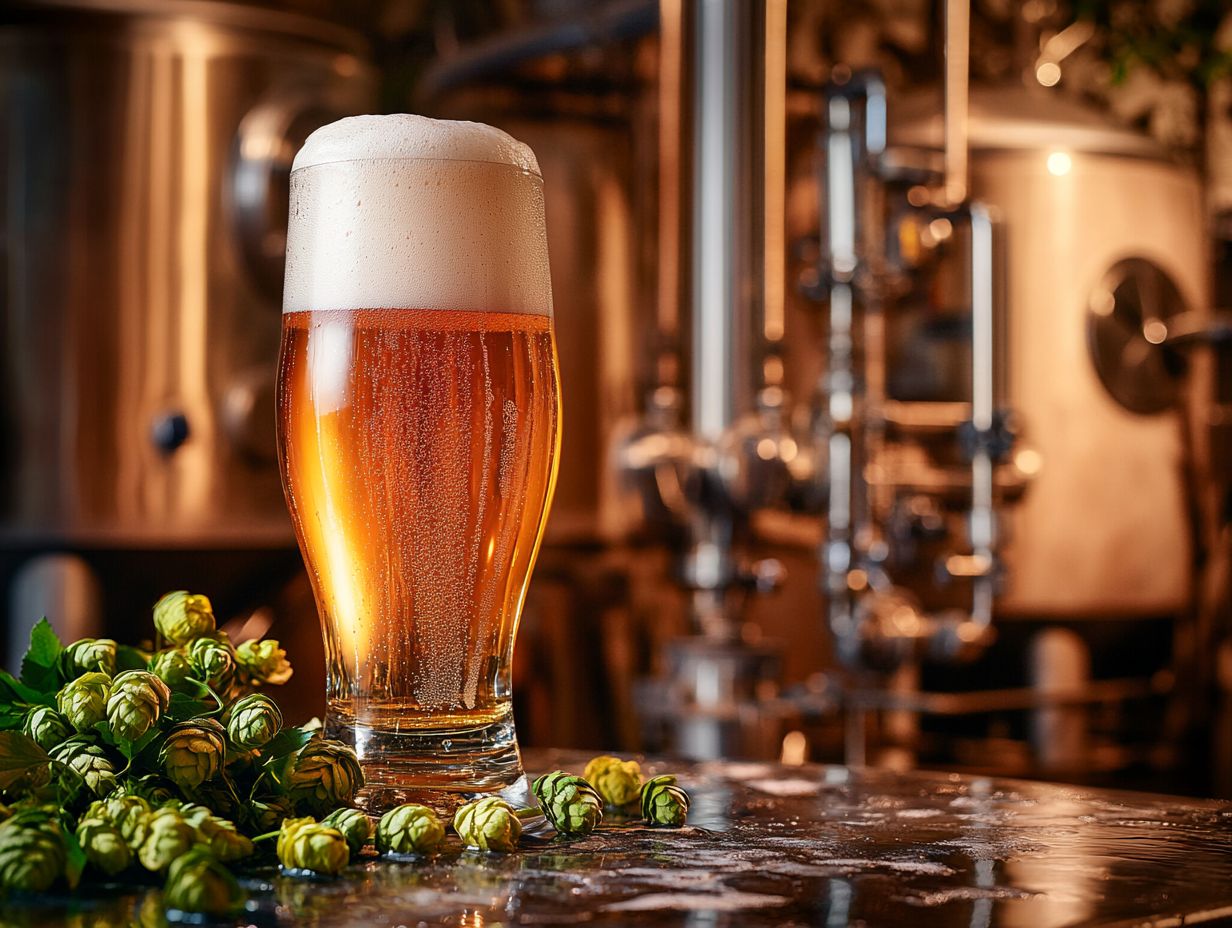
Selecting the right yeast strain is absolutely essential in the brewing process. Each strain brings its own unique flavors, aromas, and mouthfeel characteristics to your final beer.
For instance, some yeast strains excel at enhancing glycerol production, contributing to a soft mouthfeel. Others may introduce fruity esters or spicy phenols that elevate the overall flavor profile.
Your choice of yeast also dictates fermentation temperature. It is a critical aspect of brewing science that demands thoughtful consideration and experimentation.
Choosing the ideal yeast strain goes far beyond mere flavor; it fundamentally influences the very essence of your beer. Each strain interacts uniquely with the malt and hops, generating distinct byproducts that can either enhance or detract from the beer s intended character.
For example, a yeast that is able to ferment sugars efficiently might leave you with a drier finish. In contrast, a less efficient option could improve body and mouthfeel.
The fermentation process shaped by variables such as yeast health, the amount of yeast added to the beer, and starter size can significantly alter the final sensory experience of the beer. Understanding these dynamics is essential for any brewer who aspires to craft a beer that delights the taste buds and offers a remarkable sensation on the palate.
2. Fermentation Time and Temperature Control
Controlling fermentation time and temperature is essential to achieve the mouthfeel and flavor characteristics you desire in your beer. By adjusting the fermentation temperature, you can directly influence yeast activity, leading to varied performances from different yeast strains and increased glycerol production.
The length of fermentation also plays a pivotal role in how well flavors meld and mature. This ultimately impacts the beer’s finish and overall sensory experience.
Properly managing these factors is crucial in your brewing process to ensure a balanced and enjoyable beer.
Warmer fermentation temperatures produce more esters and phenols, imparting fruity or spicy notes to your finished product and enriching the complexity of both aroma and taste. Conversely, cooler temperatures can highlight cleaner profiles, making them an ideal choice for lagers.
The duration of fermentation enhances clarity and deepens flavor, allowing the delicate nuances that excite the palate to fully develop.
By paying meticulous attention to these parameters, you have the power to create exciting and unique beverages that cater precisely to your target audience, promoting an engaging tasting journey with every sip.
Don t miss out on mastering your fermentation process to elevate your brewing game!
In summary, the selection of yeast and careful control of fermentation time and temperature are vital for crafting exceptional beers. Experiment with these elements for the best results!
3. Adjuncts and Additives
The use of adjuncts and additives, such as brewing salts, plays a significant role in beer evaluation, affecting not just the sensory attributes but also the beer’s mouthfeel and finish.
In brewing, the use of adjuncts and additives can significantly enhance the mouthfeel and overall flavor complexity of your beer. Ingredients such as flaked grains bring a fuller body and softer mouthfeel, while adjuncts like lactose or oats introduce a creamy texture that perfectly complements the flavor profile. Incorporating specific brewing water compositions such as calcium salts can further fine-tune the mineral profiles of your beer.
By understanding how these adjuncts interact with the fermentation process, you can craft distinctive beers from hazy New England IPAs to rich stouts that deliver a truly memorable drinking experience. Different yeast strains and their yeast fermentation characteristics also play a vital role in achieving the desired mouthfeel.
Embracing these ingredients opens the door to a vast array of styles, where even the slightest variations can lead to profound shifts in sensory experience. For example, corn and rice can lighten the body and add crispness, making your lagers feel refreshingly bright, while honey introduces a unique sweetness and complexity. Adding hop varieties during fermentation can bring out different hop oils that influence the beer aroma and flavor intensity.
Additionally, incorporating spices or fruit can impart distinctive flavors and aromas, elevating the sensory journey even further. By skillfully balancing these components, you can achieve not just a pleasing mouthfeel but also a signature profile that sets your creations apart in a competitive market. Techniques like dry hopping and krausening can infuse complexity into flavor profiles and mouthfeel.
How Can Fermentation Flaws Affect Beer Mouthfeel?
Fermentation flaws can significantly impact the mouthfeel of your beer, resulting in sensory experiences that diminish the overall enjoyment of the beverage. Common issues can arise due to improper fermentation temperature control or unhealthy yeast suspension. Common off-flavors, like diacetyl, which carries a distinctive buttery aroma, can drastically alter your perception of mouthfeel.
Similarly, acetaldehyde introduces an unwelcome green apple flavor that disrupts the delicate balance of flavors and the overall beer perception. Furthermore, the presence of esters and fusel alcohols often a consequence of inadequate fermentation control can lead to harsh sensations on the palate, ultimately compromising the beer’s finish and overall quality.
1. Diacetyl Off-Flavor
Diacetyl is a common off-flavor in beer, often stemming from improper fermentation management, and it can significantly alter mouthfeel and the overall characteristics of your brew. This compound imparts a distinct buttery flavor that has the potential to overshadow other sensory attributes, resulting in an unpleasant drinking experience.
By understanding the causes of diacetyl production including yeast strain selection and fermentation temperature you can implement effective strategies to minimize its presence in your final product.
To manage diacetyl effectively, consider allowing for a diacetyl rest at the end of fermentation. During this crucial phase, the yeast can reabsorb diacetyl and convert it into less intrusive compounds. Pay attention to fermentation conditions, such as ensuring adequate aeration and proper pitching rates, as these factors are essential for maintaining healthy yeast activity and further reducing the risk of off-flavor development.
By focusing on specific yeast strains known for low diacetyl production and controlling the temperature profile throughout fermentation, you can enhance mouthfeel and ensure that your final beer aligns more closely with the desired flavor profiles. These proactive steps will lead to a more enjoyable and balanced craft beer experience.
2. Acetaldehyde Off-Flavor
Acetaldehyde is an off-flavor you should watch out for. It can negatively impact the mouthfeel of your beer, presenting a green apple aroma that detracts from the overall sensory experience. This compound often emerges during fermentation when the yeast isn’t healthy or viable. It fails to fully convert fermentable sugars. Its presence can throw off the flavor balance and mouthfeel, ultimately leading to a less enjoyable drinking experience. This highlights the importance of monitoring yeast health and fermentation conditions.
Beyond influencing taste, acetaldehyde can also alter the perception of body and texture. This makes your beverage seem thinner or less robust. This off-flavor presents a challenge for brewers like you. It pushes you to create a product that is not just flavorful but also satisfying in mouthfeel.
To reduce the risk of acetaldehyde development, employ several strategies:
- Maintain optimal fermentation temperatures,
- Ensure proper aeration, and
- Select healthy yeast strains that are free from contaminants.
Understanding these factors can significantly enhance your final product and elevate the overall brewing experience. Employing varied brewing techniques can also help manage off-flavors and improve the sensory attributes of the beer.
3. Esters and Fusel Alcohols
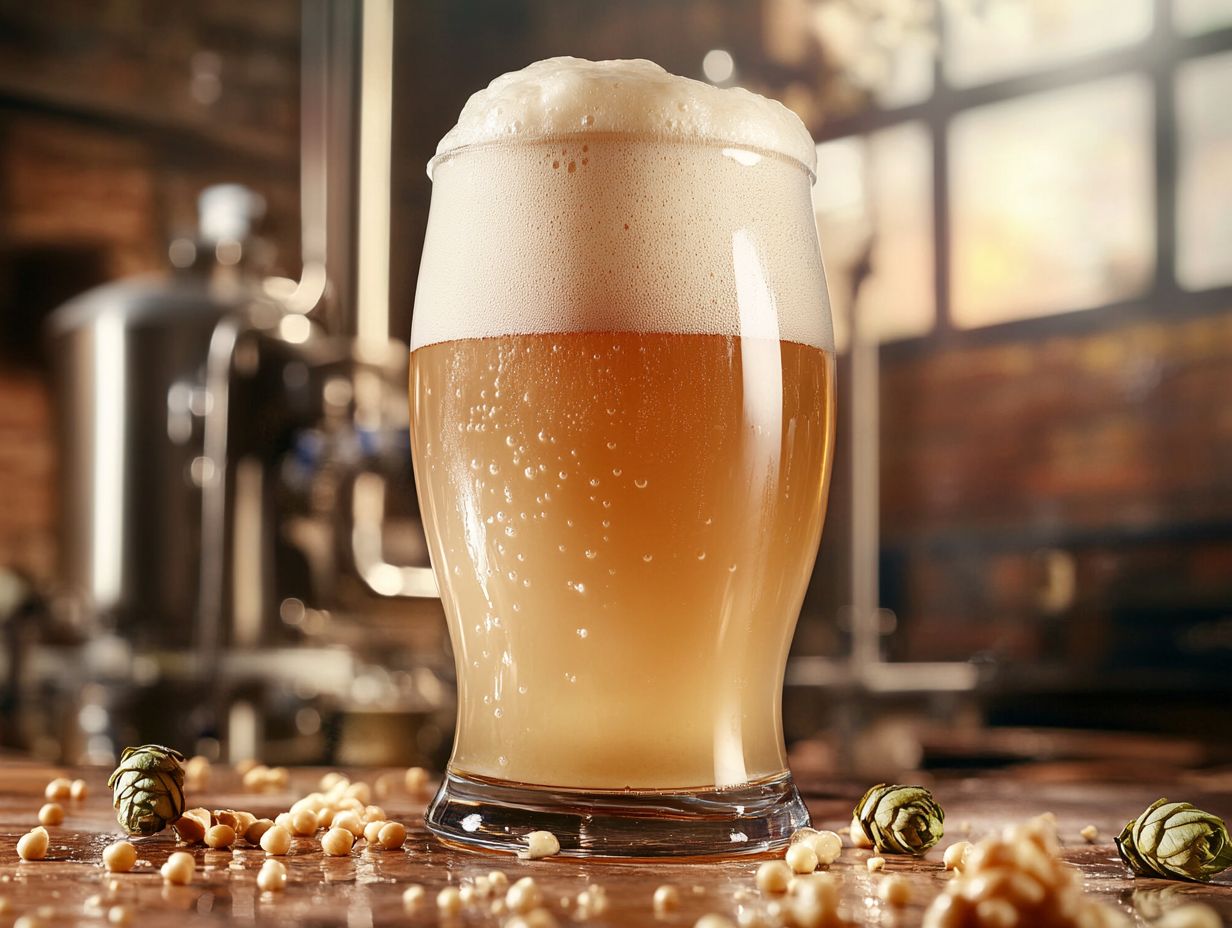
Esters and fusel alcohols are fascinating byproducts of fermentation. They significantly influence the mouthfeel and overall characteristics of your beer, especially when produced in excess. On one hand, esters bring delightful fruity flavors that enhance the complexity of your brew. On the other hand, too much fusel alcohol can introduce harshness and astringency. This negatively impacts that coveted mouthfeel.
The delicate balance of these compounds is crucial. It relates to fermentation temperature and your choice of yeast strain if you want to achieve the perfect flavor profile and mouthfeel in your creations.
These compounds arise from the metabolic activities of yeast during fermentation. Elements like temperature, wort composition, and fermentation time play pivotal roles in their production. For example, higher fermentation temperatures often lead to an increase in ester formation. This introduces lively notes of banana or pear that elevate the sensory experience. Balancing these esters with hop flavor and malt profiles is essential for a harmonious beer. However, if fermentation temperatures climb too high or the yeast becomes stressed, fusel alcohols like isoamyl alcohol can take center stage. This imparts a warming, solvent-like sensation that detracts from the smoothness of your beer.
Careful management of fermentation conditions is essential for you as a brewer. This allows you to fine-tune not just the flavor but the overall mouthfeel and impression of your beer.
What Are Some Techniques for Improving Mouthfeel through Fermentation?
You have various techniques at your disposal to enhance mouthfeel through fermentation. This ultimately elevates the overall sensory experience of your beer. Paying attention to carbonate levels and chloride levels can also impact how it tastes.
For instance, step mashing allows you to extract sugars more efficiently. This creates a richer texture. Incorporating krausening introduces fresh wort. This encourages carbonation and creates a softer mouthfeel. Combining this method with careful sulfate management can create an unforgettable taste experience.
Furthermore, techniques like dry hopping and barrel aging can infuse complexity into flavor profiles and mouthfeel. This results in distinctive characteristics that cater to a diverse array of palates.
Brewing Techniques for Enhanced Beer Quality
1. Step Mashing
-
Step mashing is an artful brewing technique that gives you the power to control the temperature during the mashing process. This allows you to influence the mouthfeel and flavor profile of your beer.
By employing various temperature rests, you can target specific enzymes that break down starches into fermentable sugars, enhancing the body and smoothness of your final product.
-
This technique proves especially valuable when incorporating adjuncts, such as flaked grains, to achieve your desired mouthfeel and complexity.
-
Through this meticulous control, the step mashing process grants you the ability to create a range of textures, from creamy and rich to light and crisp.
Each temperature rest you select serves to unlock the potential of various enzymes, such as beta-amylase (which helps convert starches to sugars) and alpha-amylase (which breaks down larger starches). These enzymes play a crucial role in affecting the wort’s viscosity and sweetness.
Utilizing different malt profiles and adjuncts like wheat adjuncts can further enhance mouthfeel softness.
-
Brewers who utilize step mashing often discover a pronounced depth in flavor. This allows their beers to present a spectrum of notes, ranging from biscuit-like maltiness to subtle fruity esters.
Experimenting with brew chemistry and brewing methods can yield unique and memorable brews.
-
The well-crafted balance between mouthfeel and flavor not only elevates the drinking experience but also highlights your artistry in crafting unique and memorable brews.
2. Krausening
Krausening is a fermentation technique that allows you to add fresh wort to your fermenting beer. This method sparks a natural carbonation process that transforms your beer into a bubbly delight, enhancing carbonation levels and improving mouthfeel.
By grasping the dynamics of krausening, you can achieve a well-rounded mouthfeel that beautifully complements the overall flavor profile of your brew.
Timing is everything when it comes to adding that fresh wort. You want to keep the yeast active to encourage lively fermentation without overwhelming the existing beer.
One of the standout advantages of krausening is its ability to produce finer, more persistent carbonation that truly enhances the drinking experience.
This natural approach not only delivers a delightful sensory experience but also preserves the aromatic qualities of the beer, making it a go-to technique for many craft brewers. Noteworthy examples include styles like M rzen or a well-crafted Saison.
The balance of carbonation and mouthfeel you achieve through krausening can elevate styles like M rzen and Hefeweizen, inviting a richer sensory profile that will undoubtedly appeal to any beer enthusiast.
3. Dry Hopping
Dry hopping is a technique you can use to elevate the aromatic qualities and mouthfeel of your beer by adding hop varieties during fermentation or conditioning. This process allows you to extract hop oils that contribute to the intensity of flavor, hop bio-transformation, and enhance the perceived mouthfeel.
By selectively choosing your hop varieties, you can achieve specific mouthfeel characteristics, whether you desire a soft, rounded texture or a more robust sensation. For instance, New England IPA often showcases a soft mouthfeel and intense hop flavor.
The timing and method by which you apply hops during this stage can significantly shape the outcome. This gives you the power to tailor the beer’s aromatic profile to align with your creative vision.
The volatile compounds found in hop oils, such as myrcene, humulene, and linalool, play pivotal roles in crafting not only the enticing aromas but also the bitter and sweet notes that harmonize in the final product. Additionally, factors like yeast suspension and glycerol production can further influence the beer’s mouthfeel and aftertaste perception.
As a result, each sip offers you a complex array of flavors, making dry hopping a favored technique among craft brewers who aspire to create unique brews that leave a lasting impression.
Try these techniques in your next brewing session to elevate your craft and impress your friends!
4. Barrel Aging
Barrel aging is a fermentation technique that elevates your beer experience by adding depth and complexity to its mouthfeel and overall character. When you age beer in wooden barrels, you allow brewers to introduce unique flavors from the wood itself while enhancing the mouthfeel through the interaction with the barrel’s natural compounds. This technique shines particularly in styles like stouts and sours, where the resulting brew features rich, layered flavors and a velvety texture that truly captivates the palate. Barrel aging can also interact with the mineral profiles of the beer, further influencing its characteristics.
The process goes beyond mere aging; it involves the careful selection of barrels made from various types of wood that may have previously held liquids like bourbon or wine. Each barrel brings its own personality to the table, imparting delightful notes of vanilla, oak, or even spice, enriching the beer’s profile with a sophisticated touch. For instance, aging a Saison in barrels can introduce unique complexities not found in typical fermentation processes.
The oxygen exchange during barrel aging works its magic, softening any harsh flavors and resulting in a smoother texture that enhances overall drinkability. This process also affects the beer’s carbonation levels and can significantly alter yeast viability over time.
This complexity makes barrel-aged varieties a prized choice among craft beer enthusiasts, broadening their appeal across a variety of styles. Even IPAs and Belgian ales can benefit from this extra depth, all while maintaining their distinctive characteristics. The impact of brewing techniques and brewing methods cannot be understated in achieving these results.
Understanding the intricacies of beer perception and brewing experiments can significantly enhance your brewing techniques, whether you’re using flaked grains or exploring the role of sugar alcohol in achieving mouthfeel softness.
Frequently Asked Questions
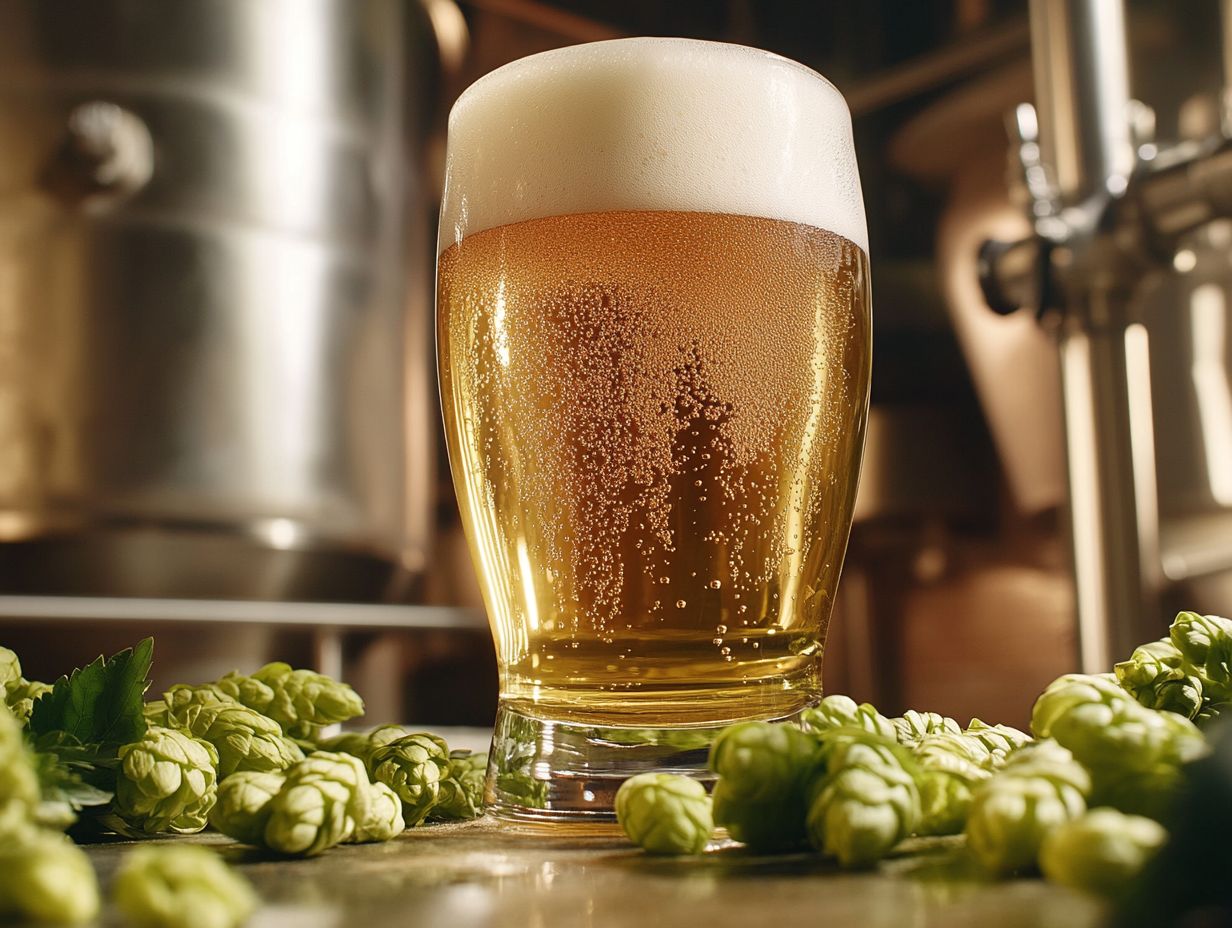
Understanding the intricacies of beer perception and brewing experiments can significantly enhance your brewing techniques, whether you’re using flaked grains or exploring the role of sugar alcohol in achieving mouthfeel softness.
What is fermentation and how does it affect the mouthfeel of beer?
Fermentation is the process in which yeast converts sugars into alcohol and carbon dioxide. During this process, various chemical compounds are produced that contribute to the overall mouthfeel of beer. These compounds include carbonation, alcohol, esters, and acids. The fermentation temperature and brewing water also play crucial roles in defining the beer’s characteristics.
How does carbonation from fermentation impact the mouthfeel of beer? How does brewing water influence the final product?
Carbonation is responsible for the bubbles and effervescence in beer, which adds a level of texture and crispness to the mouthfeel. It also aids in releasing flavor and aroma compounds, enhancing the overall drinking experience. Additionally, carbonation levels can influence the sensory attributes and flavor balance of the beer.
What role do esters play in the mouthfeel of beer during fermentation? How does the selection of yeast strains affect this?
Esters are fruity, aromatic compounds that are a byproduct of fermentation. They can contribute to the perceived sweetness and fullness of a beer’s mouthfeel, as well as add complexity and depth to the overall flavor profile. The type of yeast strains used during fermentation can significantly impact the ester production.
How does the alcohol content of beer impact its mouthfeel? What is the role of fermentation temperature?
Alcohol has a numbing effect on the taste buds and can create a warming sensation in the mouth, contributing to the overall mouthfeel of beer. It also acts as a solvent, helping to release flavors and aromas from the other ingredients in the beer. Alcohol content is a critical factor in the beer’s finish and body sip experience.
What role do acids play in the mouthfeel of beer during fermentation? How do calcium salts influence this?
Acids, such as lactic and acetic acid, can add a sour or tangy taste to beer and contribute to its perceived level of acidity. This can enhance the overall mouthfeel by providing a refreshing and crisp sensation on the palate. The chloride levels and sulfate levels in the brewing water can further influence the acidity and overall flavor profile.
How Does the Length of Fermentation Impact the Mouthfeel of Beer?
The Effects of Fermentation Length
The length of fermentation affects the mouthfeel of beer in various ways. Longer fermentation times can produce higher alcohol levels and more intricate tastes.
In contrast, shorter fermentation times may result in a lighter and crisper mouthfeel. Different beer styles need varying fermentation lengths for the best mouthfeel.
Brewing Chemistry
For example, a bitter IPA benefits from a longer fermentation process to develop its strong flavor.

